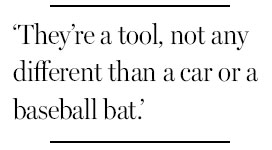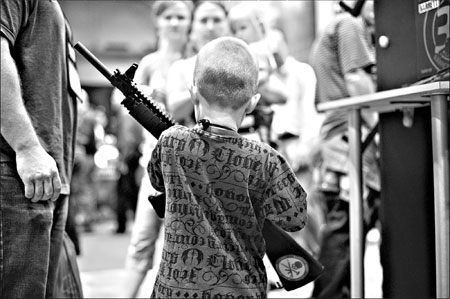Selling children on firearms
Updated: 2013-02-03 07:37
By Mike Mcintire (The New York Times)
|
|||||||||||
|
The firearms industry is campaigning to interest more - and younger - children in shooting sports. Daniel Acker for The New York Times |

Threatened by declining participation in shooting sports, the American firearms industry has poured millions of dollars into a campaign to get guns into the hands of more, and younger, children.
The industry is giving firearms, ammunition and cash to youth groups; weakening state restrictions on hunting by children; marketing a military-style rifle for "junior shooters" and sponsoring semiautomatic-handgun competitions for youths; and developing a target-shooting video game that promotes brand-name weapons.
The pages of Junior Shooters, an industry-supported magazine, once featured a 15-year-old girl clutching a semiautomatic rifle. The article extolled target shooting with a Bushmaster AR-15 and encouraged youngsters to share the information with a parent. "Who knows?" it said. "Maybe you'll find a Bushmaster AR-15 under your tree some frosty Christmas morning!"
The youth-marketing effort is backed by research and carried out by nonprofit groups financed by the gun industry, an examination by The New York Times found.
A study last year by the shooting sports industry suggested encouraging children ages 8 to 17 to become "peer ambassadors" to introduce other youngsters to guns slowly, perhaps through paintball or archery.
"The point should be to get newcomers started shooting something, with the natural next step being a move toward actual firearms," said the report prepared for the National Shooting Sports Foundation and the Hunting Heritage Trust.
Some child psychiatrists say encouraging youthful exposure to guns, even in a structured setting with an emphasis on safety, is asking for trouble. Dr. Jess P. Shatkin, the director of undergraduate studies in child and adolescent mental health at New York University, said that young people are naturally impulsive and that their brains "are engineered to take risks."
"There are lots of ways to teach responsibility to a kid," Dr. Shatkin said. "You don't need a gun to do it."
The gun industry's major political advocate, the National Rifle Association of America, has for decades supported youth shooting programs that involved single-shot rimfire rifles, BB guns and archery. Its $21 million in grants in 2010 was nearly double what it gave out five years earlier.
Other organizations also seek to introduce children to high-powered rifles and handguns while invoking the same rationale of those older, more traditional programs: that firearms can teach responsibility, ethics and citizenship.
Steve Sanetti, the president of the National Shooting Sports Foundation, said it should be left to parents to decide if and when to introduce their children to shooting and what sort of firearms to use.
The foundation's national headquarters is in Newtown, Connecticut, just a few kilometers from Sandy Hook Elementary School, where Adam Lanza, 20, used his mother's Bushmaster AR-15 to kill 20 children and 6 adults in December.
Shooting sports and gun sales have enjoyed a rebound recently, but the long-term demographics are not favorable, as urbanization, the growth of indoor pursuits like video games and changing cultural mores erode consumer interest. Licensed hunters fell from 7 percent of the American population in 1975 to fewer than 5 percent in 2005, according to federal data.
Some foundation-sponsored research studies asked teenagers to explore their feelings about guns and people who use them, and offered strategies for generating a greater acceptance of firearms.
One study concluded that "stakeholders such as managers and manufacturers should target programs toward youth 12 years old and younger."
Mr. Sanetti said the youth-centered research was driven by the inevitable "tension" the industry faces, given that no one under 18 can buy a rifle or a shotgun from a licensed dealer or even possess a handgun under most circumstances.
The foundation and gun companies also support Junior Shooters magazine, based in Idaho. Junior Shooters' editor, Andy Fink, said there is no legitimate reason children should not learn to safely use an AR-15 for recreation.
"They're a tool, not any different than a car or a baseball bat," Mr. Fink said.
The AR-15, the civilian version of the military's M-16 and M-4, has been aggressively marketed as a step up from more traditional target and hunting rifles. But its appearance in recent mass shootings has prompted calls for tighter restrictions.
Stephan Carlson, a University of Minnesota environmental science professor whose research on the positive effects of learning hunting and outdoor skills has been cited by the gun industry, said he "wouldn't necessarily go along" with introducing children to more powerful firearms.
"I see why the industry would be pushing it, but I don't see the value in it," Mr. Carlson said. "I guess it goes back to the skill base we're trying to instill in the kids. What are we preparing them for?"
The New York Times
(China Daily 02/03/2013 page10)
Today's Top News
Police continue manhunt for 2nd bombing suspect
H7N9 flu transmission studied
8% growth predicted for Q2
Nuke reactor gets foreign contract
First couple on Time's list of most influential
'Green' awareness levels drop in Beijing
Palace Museum spruces up
Trading channels 'need to broaden'
Hot Topics
Lunar probe , China growth forecasts, Emission rules get tougher, China seen through 'colored lens', International board,
Editor's Picks

|

|

|

|

|

|






